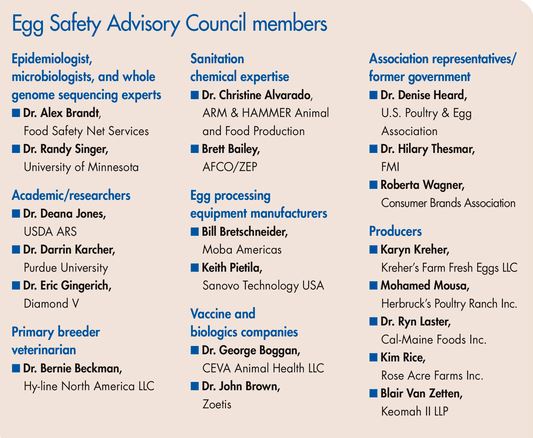September 15, 2020
Council is made up of 20 individuals who will focus on assuring the safety and quality of eggs produced in the US
By Deven King, Watt Ag Egg Industry News, September 2020
Food safety is and will continue to be a critical part of the nation's egg supply. The United Egg Producers (UEP) is working with individuals from various facets of the egg industry to ensure any food safety concerns are addressed and researched through its new Food Egg Safety Advisory Council (FSAC).
 Oscar Garrison, senior vice president of food safety with UEP, recently sat down with Deven King, managing editor of Egg Industry magazine, to give insight into the new council.
Oscar Garrison, senior vice president of food safety with UEP, recently sat down with Deven King, managing editor of Egg Industry magazine, to give insight into the new council.
KING: What is the main purpose of the Food Safety Advisory Council?
GARRISON: The UEP Food Safety Advisory Council was created in reflection of our continuing commitment to assuring the safety and quality of eggs produced by America’s egg farmers. This is another example of our intent to continuously evaluate and improve our egg safety practices.
The council has the following mission: To provide input and insight to UEP on current and future issues affecting the industry such as food safety initiatives and programs, microbiology and emerging pathogens, research needs and results, epidemiology and whole genome sequencing, educational needs and availability, and the changing regulatory environment.
The new Food Safety Advisory Council replaces UEP’s original Food Safety Scientific Advisory Council that was formed to provide expertise as the FDA (Food and Drug Administration) Egg Safety Rule was implemented across the industry. UEP thanks the dedicated scientists who provided expertise in the development of viable practices to improve egg safety.
K: Who sits on the council?
G: The council is comprised of 20 subject-matter experts, each of whom brings unique and relevant perspectives to the council. The council will provide recommendations and creative solutions for current and future food safety challenges within the egg industry.
K: Why is it so important to have every facet of the industry represented?
G: There are distinct and varied perspectives within egg production and egg safety. Bringing together a diverse group of individuals who focus on areas within the daily production of shell egg and egg products will provide immense benefits to the industry. Although many things were learned during the Salmonella Braenderup outbreak, more questions remain. The diversity of the group will allow each participant to weigh in on their areas of expertise to build creative long-term solutions and best practices for the industry.
K: What are your initial goals for the committee?
G: Research needs will be at the forefront of the early discussions within the group. This research will help guide and navigate the actions taken and set priorities going forward.
The Salmonella Braenderup study that is ready to kick off at the U.S. Department of Agriculture Agricultural Research Service (USDA ARS) provides an example of how the council will engage in addressing a series of egg safety questions. In this scenario, first we must determine if the outbreak strain is different from other strains that have been isolated in layer houses. Has the molecular makeup of this bacteria changed over time? Is it a surface contamination issue we must address, or has it garnered the ability to vertically transmit into the contents of the egg?
The answer to these questions will determine the path and recommendations of the group to the industry. Surface contamination will be in the sanitation and equipment manufacturers’ expertise, while a vertical transmission would involve biologic experts, primary breeders and tapping into the NPIP expertise of our past government/ industry association members. The overarching goal is to keep the finger on the pulse of pressing issues and utilize the expertise of the council to stay ahead of future issues.
K: Could you elaborate at all on the Salmonella Braenderup study that is ready to kick off at USDA ARS?
G: The study focuses on the internal organ colonization and vertical transmission by Salmonella Braenderup by experimentally infected laying hens in cage-free housing. A study has been initiated to determine the ability of the egg-associated human outbreak strain of Salmonella Braenderup to colonize organs and vertically transmit into eggs laid by experimentally inoculated cage-free laying hens.
The study is utilizing the specific strain of Braenderup from the 2018 outbreak linked to eggs that was isolated during the investigation and obtained from CDC (the Centers for Disease Control and Prevention) to experimentally infect the hens to determine if the organism shows signs of vertically transmitting into the eggs laid by the hens.

K: Will the committee investigate ways to teach consumers about egg safety?
G: Consumer education is always an important part of egg safety messaging, and our consumer education to date has been led by the digital resources of the Egg Safety Center. UEP will continue to partner with AEB and other stakeholders to assure the effectiveness of current Egg Safety Center resources in reaching consumers and to determine any new initiatives to provide consumer education on egg safety moving forward.
K: How has COVID-19 impacted the council’s ability to get together or move forward with plans?
G: 2020 has brought forward a unique set of circumstances for establishing relationships needed within the group without the ability to have a face-to-face meeting. With the caliber of individuals involved in the FSAC and their work and professional responsibilities, finding the time for conference calls or webinars has been challenging as well.
Most of the council members have been attending to COVID-19 issues affecting their daily world and work environments. UEP is in the process of scheduling a webinar soon to review existing research plans, current egg safety initiatives, and giving everyone the opportunity to voice what they see as challenges in the industry that need addressing. Priorities will be established as we move forward, and the background research is completed.
In closing, Garrison said U.S. egg producers welcome and appreciate the work of the council and the members’ expertise in guiding egg safety practices and building a framework to evaluate and respond to future egg safety issues within the industry.
https://www.eggindustry-digital.com/eggindustry/september_2020/MobilePagedArticle.action?articleId=1619915&app=false#articleId1619915
For video, photos and other resources, view Resources.
For media inquiries or
interview requests, contact Hinda Mitchell.